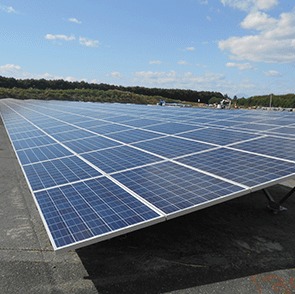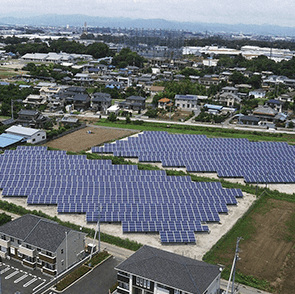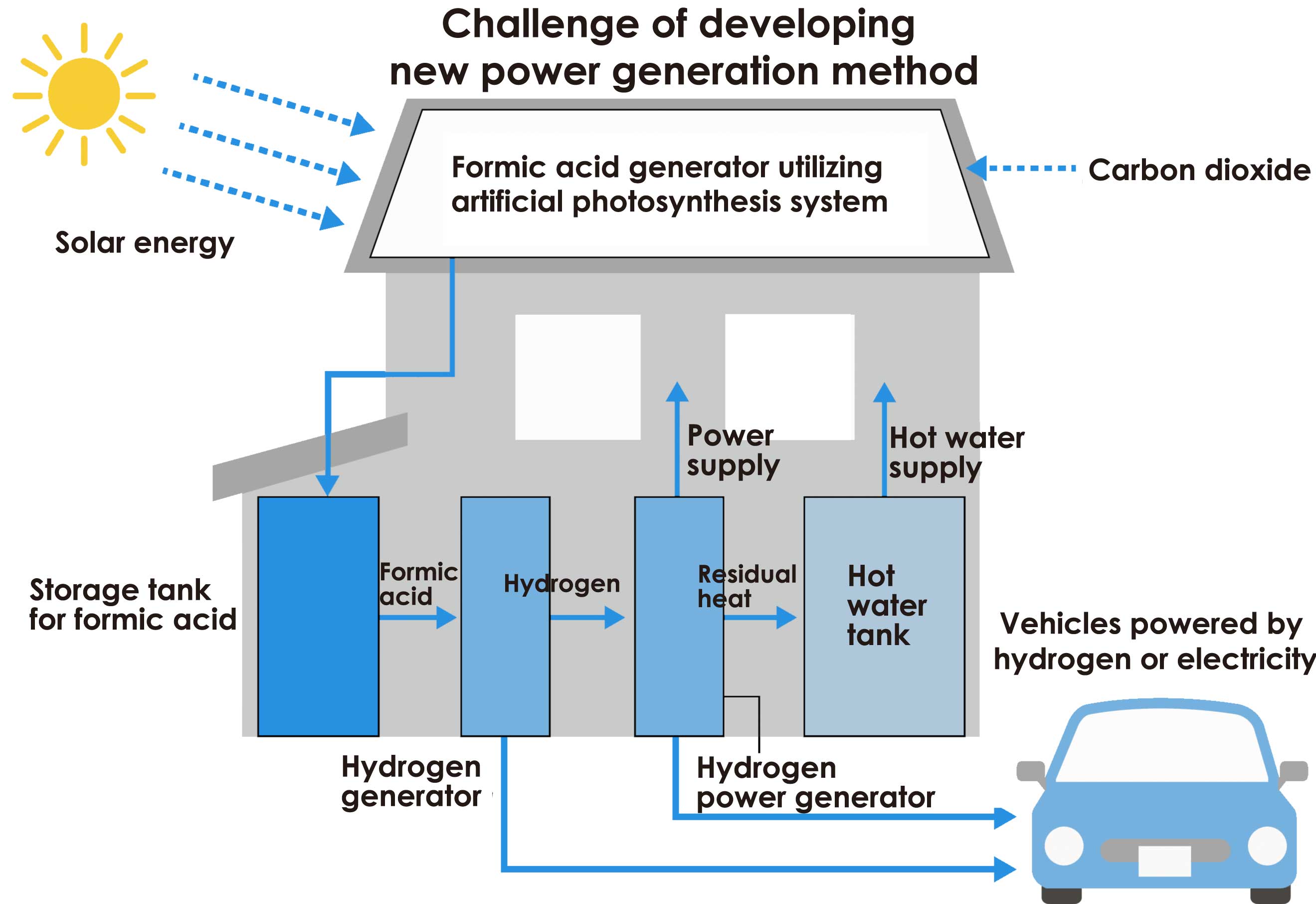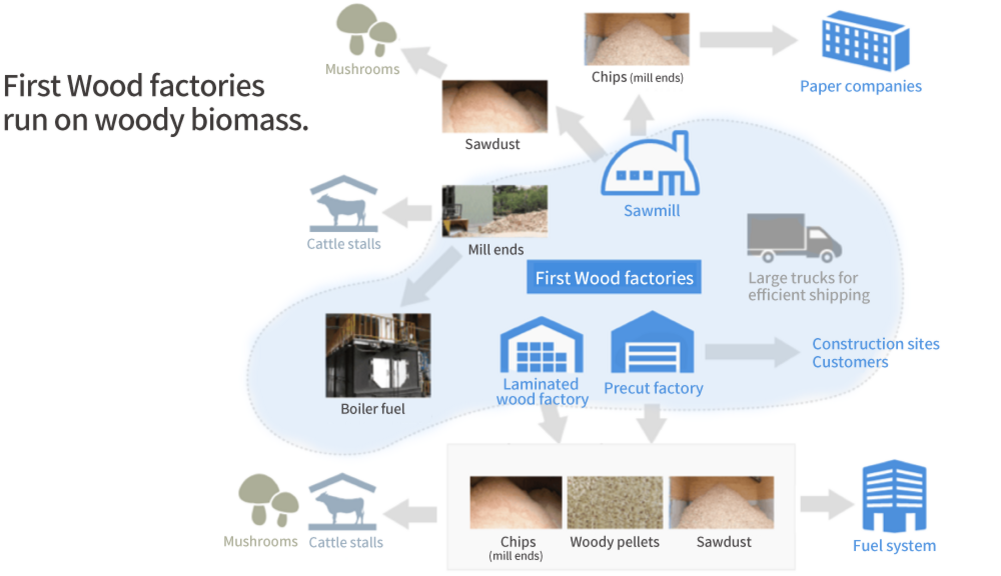A large amount of wood is used in single-family houses, which are the mainstay business of our group. Because wood has the ability to continuously store atmospheric CO2 absorbed through photosynthesis as carbon, increasing the number of wooden buildings in cities is also referred to as "second forest creation." Our group strives to create a sustainable society through the stable supply of housing.
A wooden house that connects to forest circulation
As trees get older, their ability to absorb CO2 decreases, so by cutting down trees that are over a certain age and planting and growing younger trees, you can increase the CO2 absorption capacity of the entire forest.
The systematic felling of trees to build wooden houses promotes healthy forest circulation.


Carbon storage of wooden houses
The amount of carbon stored per wooden house is estimated to be 6 tC (tons of carbon) (*1), and wooden houses store about four times as much carbon as steel prefabricated houses or reinforced concrete houses.
Additionally, compared to materials such as steel and concrete, wood releases less carbon during manufacturing and processing, so promoting the use of wood will contribute to reducing CO2 emissions.
Our group supplies approximately 43,000 wooden houses annually, which is calculated to store approximately 190,000 tC of carbon.




- *1 Calculated based on the results of an estimate based on a typical wooden house (134㎡) (Forestry Agency "FY2020 Forests and Forestry White Paper") and the average total floor area of our group (approximately 100㎡).
Reducing CO2 emissions through group uniform quality standards
Our group's unified quality standards are ''Insulation Performance Grade 4'' or higher and ''Primary Energy Consumption Grade 5'' or higher under the Housing Performance Indication System, and all of our detached houses are certified. (*1) The energy consumption of a house with this performance is 3.1 tons per year.
This has an approximately 15% reduction effect compared to the CO2 emissions of a typical house (*2). (*3)
Based on the standards as of March 2023, approximately 80% of the homes supplied by our group meet the higher-performance ZEH standard (*4) of ''insulation performance grade 5" and "primary energy consumption grade 6" is obtained. A house with this performance has an approximately 20% reduction effect compared to a typical house.
| general housing | Iida group quality standards |
Iida Group's residential ZEH standards (*5) | |
|---|---|---|---|
| Insulation performance grade | grade 4 | grade 4 | grade 5 |
| primary energy consumption class |
grade 4 | grade 5 | grade 6 |
| energy consumption (CO2 equivalent amount) *4 |
3.69 tons | 3.15 tons | 2.98 tons |
| with general housing reduction ratio |
- | 14.6% | 19.3% |
- *1 Applies to newly built condominiums for which our group has entered into a sales contract as the seller on or after April 1, 2022. Detached houses for sale do not include custom-built houses, overseas properties, or brokered properties. Based on the laws and systems in effect as of April 1, 2022, and may change due to legal revisions, etc.
- *2 “General housing” is a residence that has acquired “heat resistance performance class 4” and “primary energy consumption class 4.”
- *3 ZEH housing refers to housing where the actual energy cost is zero (Net Zero Energy). A house that has obtained both "insulation performance grade 5" and "primary energy consumption grade 6" under the Housing Performance Indication System is called a ZEH standard house. (As of April 2022)
- *4 Energy consumption (CO2 equivalent) is calculated using the "Energy Consumption Performance Calculation Program" (Building Research Institute) based on in-house data.
- *5 As of October 2022
Renewable energy
Woody biomass
"Biomass" is a word that expresses the amount (mass) of biological resources (bio), and refers to "renewable, biologically derived organic resources (excluding fossil fuels)". Among these, biomass made of wood is called "woody biomass."
(Quoted from the Forestry Agency)
First Wood Co., Ltd. makes effective use of woody biomass. The sawdust produced during lumber milling can be used for mushrooms and the flooring of cowsheds, and the chips can be used as raw material for paper by paper companies.
In addition, we use bark, sawdust, and other waste discharged from our own factories as fuel for large boilers with in-house power generation, allowing us to efficiently obtain the steam necessary for drying wood and the electricity necessary for factory operations.
Furthermore, we are working to build a business that collects and recycles wood scraps that are difficult to dispose of throughout the country.
Solar power generation business
There is still a need to promote the spread of "renewable energy" that reduces environmental impact and can be safely used by the next generation. Therefore, Ichi Construction Co., Ltd. and Toei Jujutsu Co., Ltd. are installing and operating solar power generation equipment for the purpose of creating "renewable energy." In addition to our main business, the detached house sales business, we utilize a lot of information that we receive when purchasing land, as well as the use of idle land we own.

Ichi Construction Co., Ltd. Solar Power Generation Facility (Moka City, Tochigi Prefecture)

Toei Housing Solar Power Generation Facility Co., Ltd. (Oizumi Town, Oura District, Gunma Prefecture)
Research and development towards realizing a sustainable society
Toward the realization of a "hydrogen society," we use our unique artificial photosynthesis technology to generate and store formic acid from carbon dioxide and water, or organic matter derived from carbon dioxide, and then use the hydrogen generated from this formic acid to generate electricity for household use. We are conducting research and development on the "IG Perfect Eco House," a house that can provide electricity for
Aiming to establish this technology, we are promoting joint research with Osaka Public University, working on improving the efficiency of formic acid and hydrogen generation, building a power generation mechanism, and improving the durability of equipment.
Additionally, in preparation for the mandatory installation of renewable energy equipment, we are considering multiple options, including artificial photosynthesis technology and collaboration with suppliers of alternative products such as solar power generation equipment.



